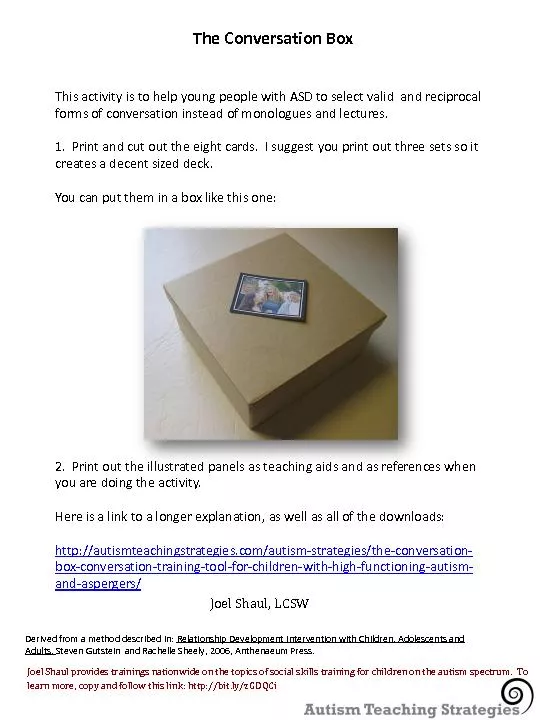/


Relationship Development Intervention with Children Adolescents and Adults Steven Gutstein and Rachelle Sheely 2006 Anthenaeum Press The Conversation Box This activity is to help young people ID: 470822
Download Pdf The PPT/PDF document "Derived from a method described in:" is the property of its rightful owner. Permission is granted to download and print the materials on this web site for personal, non-commercial use only, and to display it on your personal computer provided you do not modify the materials and that you retain all copyright notices contained in the materials. By downloading content from our website, you accept the terms of this agreement.
Derived from a method described in: Relationship Development Intervention with Children, Adolescents and Adults, Steven Gutstein and Rachelle Sheely, 2006, Anthenaeum Press. The Conversation Box This activity is to help young people with ASD to select valid and reciprocal forms of conversation instead of monologues and lectures. 1. Print and cut out the eight cards. I suggest you print out three sets so it creates a decent sized deck. You can put them in a box like this one: 2. Print out the illustrated panels as teaching aids and as references when you are doing the activity. Here is a link to a longer explanation, as well as all of the downloads: http://autismteachingstrategies.com/autism - strategies/the - conversation - box - conversation - training - tool - for - children - with - high - functioning - autism - and - aspergers/ Making plans together Sharing feelings together Remembering things together Comparing interests Comparing what you think Figuring something out together Making something funny together Creating fantasies together Making plans together “How about if we…” “Do you think we could…” “Hey, let’s…” “Do you want to…” “What are you doing later?” a utism t eaching s trategies.com Sharing feelings together “That makes me feel ______. How does that make YOU feel?” “I’m worried. What about you?” “I will be so happy when _____. How about you?” “Are you feeling _______? Me too.” a utism t eaching s trategies.com Comparing interests “I’m interested in _______. Are you?” “I like _________. How about you?” “I can’t stand _____. What about you? “________ is bad. What do you think?” a utism t eaching s trategies.com Remembering things together “Do you remember that time when…?” “Remember when you and I…?” “I was thinking about back when our whole class…” “I can remember when we _______. Do you?” a utism t eaching s trategies.com Comparing what you think “I think that _________. What do you think?” “My family believes ______. How about yours?” “ I see your point.” “I agree.” “I disagree.” a utism t eaching s trategies.com Figuring something out together “How should we…” “Can I help you to…” “Can you help me to…” “Let’s try together to…” “What should I do?” a utism t eaching s trategies.com Creating fantasies together [Example:“What would you think if soda came out of the drinking fountain?”] “Wouldn’t it be great if…” “Wouldn’t it be crazy if…” a utism t eaching s trategies.com Making something funny together “Do you want to hear something funny?” “What you just said cracked me up!” “Did you hear the joke about…” “I saw something funny. Do you want to see it?” a utism t eaching s trategies.com